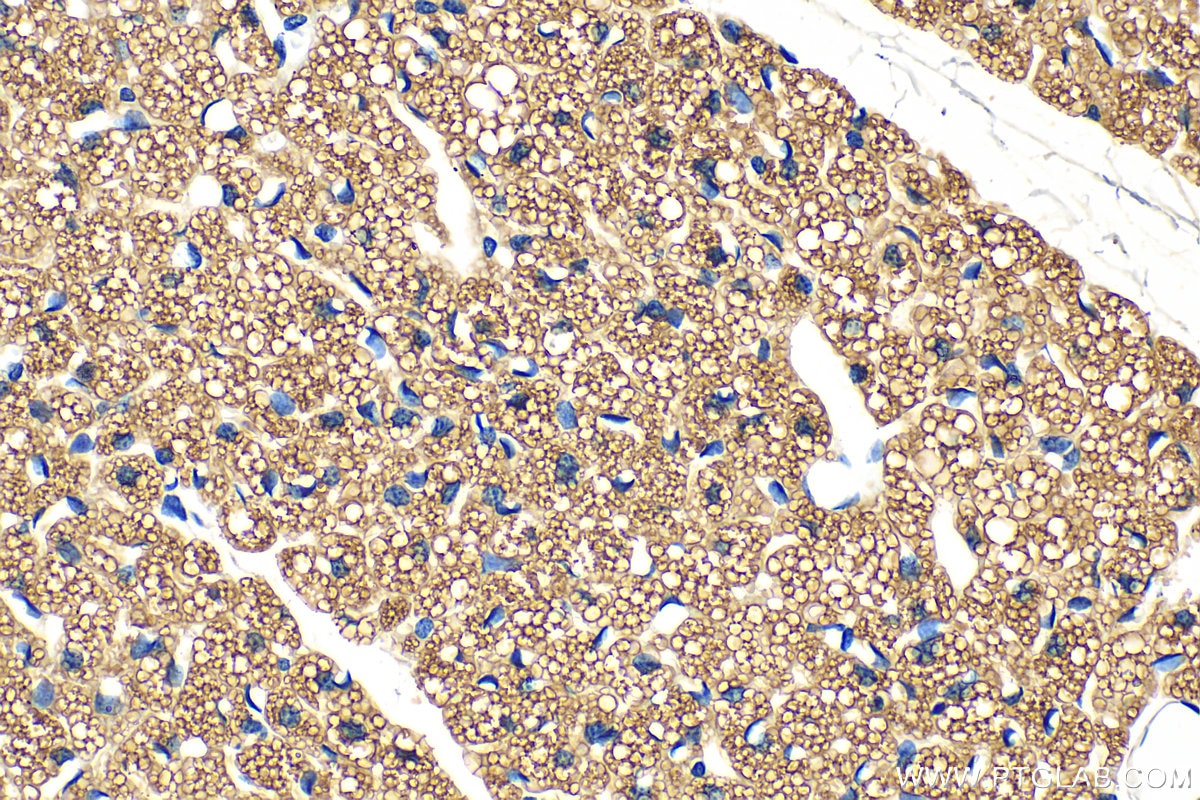Anticorps Polyclonal de lapin anti-HSL
HSL Polyclonal Antibody for WB, IHC, ELISA
Hôte / Isotype
Lapin / IgG
Réactivité testée
Humain, porc, souris et plus (4)
Applications
WB, IHC, IF, IP, ELISA
Conjugaison
Non conjugué
N° de cat : 17333-1-AP
Synonymes
Galerie de données de validation
Applications testées
| Résultats positifs en WB | tissu adipeux de souris, tissu adipeux de porc |
| Résultats positifs en IHC | tissu adipeux brun de souris, tissu testiculaire de souris il est suggéré de démasquer l'antigène avec un tampon de TE buffer pH 9.0; (*) À défaut, 'le démasquage de l'antigène peut être 'effectué avec un tampon citrate pH 6,0. |
Dilution recommandée
| Application | Dilution |
|---|---|
| Western Blot (WB) | WB : 1:1000-1:8000 |
| Immunohistochimie (IHC) | IHC : 1:200-1:800 |
| It is recommended that this reagent should be titrated in each testing system to obtain optimal results. | |
| Sample-dependent, check data in validation data gallery | |
Applications publiées
| WB | See 28 publications below |
| IHC | See 3 publications below |
| IF | See 4 publications below |
| IP | See 1 publications below |
Informations sur le produit
17333-1-AP cible HSL dans les applications de WB, IHC, IF, IP, ELISA et montre une réactivité avec des échantillons Humain, porc, souris
| Réactivité | Humain, porc, souris |
| Réactivité citée | rat, bovin, Humain, poisson-zèbre, porc, singe, souris |
| Hôte / Isotype | Lapin / IgG |
| Clonalité | Polyclonal |
| Type | Anticorps |
| Immunogène | HSL Protéine recombinante Ag11360 |
| Nom complet | lipase, hormone-sensitive |
| Masse moléculaire calculée | 117 kDa |
| Poids moléculaire observé | 84 kDa |
| Numéro d’acquisition GenBank | BC070041 |
| Symbole du gène | HSL |
| Identification du gène (NCBI) | 3991 |
| Conjugaison | Non conjugué |
| Forme | Liquide |
| Méthode de purification | Purification par affinité contre l'antigène |
| Tampon de stockage | PBS with 0.02% sodium azide and 50% glycerol |
| Conditions de stockage | Stocker à -20°C. Stable pendant un an après l'expédition. L'aliquotage n'est pas nécessaire pour le stockage à -20oC Les 20ul contiennent 0,1% de BSA. |
Informations générales
Hormone sensitive lipase (HSL) belongs to the 'GDXG' lipolytic enzyme family. In adipose tissue and heart, it primarily hydrolyzes stored triglycerides to free fatty acids, while in steroidogenic tissues, it principally converts cholesteryl esters to free cholesterol for steroid hormone production. HSL has two isoforms with the molecular mass of 117 kDa and 84 kDa.
Protocole
| Product Specific Protocols | |
|---|---|
| WB protocol for HSL antibody 17333-1-AP | Download protocol |
| IHC protocol for HSL antibody 17333-1-AP | Download protocol |
| Standard Protocols | |
|---|---|
| Click here to view our Standard Protocols |
Publications
| Species | Application | Title |
|---|---|---|
Ecotoxicol Environ Saf Paternal cadmium exposure affects testosterone synthesis by reducing the testicular cholesterol pool in offspring mice | ||
Int J Biol Sci LAMC1-mediated preadipocytes differentiation promoted peritoneum pre-metastatic niche formation and gastric cancer metastasis. | ||
Biochim Biophys Acta Mol Cell Biol Lipids DECR1 directly activates HSL to promote lipolysis in cervical cancer cells. | ||
Biochim Biophys Acta Mol Cell Biol Lipids PLK1 promotes cholesterol efflux and alleviates atherosclerosis by up-regulating ABCA1 and ABCG1 expression via the AMPK/PPARγ/LXRα pathway | ||
Epigenetics Differential regulatory roles of microRNAs during intramuscular adipogenesis in Chinese Guizhou Congjiang Xiang pigs. | ||
Food Funct Gentisic acid prevents diet-induced obesity in mice by accelerating the thermogenesis of brown adipose tissue. |






